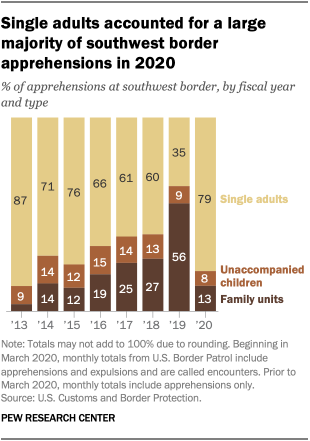
Border Patrol agents apprehended about half as many migrants at the U.S.-Mexico border in fiscal 2020 as they did the year before, according to newly released federal data. The sharp drop in the number of apprehended migrants follows a virtual shutdown of the border and new restrictions in the way asylum cases are handled in response to the coronavirus outbreak.
Below is a closer look at the shifting dynamics at the southwestern border, based on the new numbers from U.S. Customs and Border Protection, the federal agency tasked with patrolling the border. How we did this

Following a dramatic rise in fiscal 2019, apprehensions at the U.S.-Mexico border fell by about half in fiscal 2020 as COVID-19 closed borders. There were 400,651 apprehensions in the 2020 fiscal year (October 2019-September 2020), a 53% decrease from the previous fiscal year, when apprehensions soared to their highest level in 12 years. The fiscal 2020 total was generally on par with other recent years and far below the 1,643,679 recorded in the peak year of 2000. Border apprehensions regularly exceeded 1 million per fiscal year during the 1980s, 1990s and 2000s.
The decrease in apprehensions comes as the movement of migrants in the Americas and worldwide has slowed during the COVID-19 outbreak, with governments fully or partially closing their borders to stem its spread.
In March, Mexico restricted nonessential travel across its border with the United States, while the governments of El Salvador, Guatemala and Honduras also implemented restrictions on movement. Most migrants apprehended at the U.S.-Mexico border in recent years have come from Mexico and Central American nations.

In a shift, Mexicans far outnumbered non-Mexicans among those apprehended at the border in fiscal 2020. Mexican citizens accounted for 63% of the total number apprehended, marking the first year in the last five in which they outnumbered citizens of other countries. The change represents a return to the pattern observed throughout the 2000s and 2010s. For example, in 2000 (the earliest year for which data is available), Mexicans accounted for 98% of apprehensions while non-Mexicans accounted for just 2%.
Border agents apprehended a total of 253,118 Mexicans in fiscal 2020, up from 166,458 the year before and the highest total in seven years. The increase comes despite a steep decline in apprehensions of Central American migrants in fiscal 2020. The U.S. apprehended 47,243 migrants from Guatemala, down from 264,168 the year before; 40,091 from Honduras, down from 253,795; and 16,484 from El Salvador, down from 89,811.

Single adults accounted for the majority of apprehensions in fiscal 2020, another big shift from last year. There were 317,864 apprehensions of single adults, representing 79% of the total and the largest number of single adults apprehended in six years. Apprehensions of “family units” – defined as the number of individuals traveling in a family – made up 13% of the total, falling from 473,682 in fiscal 2019 to 52,230 this past year. Meanwhile, apprehensions of unaccompanied children ages 17 and younger also decreased from their peak in fiscal 2019, from 76,020 to 30,557.
The changing profile of those being apprehended at the border follows changes in the way the U.S. government is handling border apprehensions during the coronavirus outbreak. In March, citing the pandemic, the Trump administration issued an order allowing Border Patrol agents to swiftly expel migrants they consider health risks to their home country or their last transit country (in this case Mexico). The order covers asylum seekers and unaccompanied children. Since April, the first full month after the order, these expulsions have accounted for 91% of the Border Patrol’s total apprehensions at the southwest border.
Apprehensions fell in nearly every border sector in fiscal 2020, particularly in the Rio Grande sector. The Rio Grande region saw a 73% drop in migrant apprehensions in fiscal 2020 compared with fiscal 2019, from 339,135 to 90,206. That was by far the largest numerical decrease of any of the nine southwest Border Patrol sectors. The El Paso sector saw a decrease of 70%, from 182,143 apprehensions to 54,396. Despite these decreases, the Rio Grande and El Paso sectors still ranked first and third, respectively, in overall apprehensions.


Seasonal migration patterns have changed in recent years. Since 2000, border apprehensions have typically peaked in the spring – most often in March – before declining during the hot summer months, when migration journeys become more perilous. But the pattern has changed since 2013, with the annual peak occurring in months other than March. In fiscal 2020, September was the peak month, with 54,771 apprehensions.
Following the onset of the pandemic, apprehensions fell from 30,389 in March to 16,182 in April. But they started to increase in May before peaking in the final month of the fiscal year.
Note: This is an update to a post originally published on May 19, 2020.



Be the first to comment